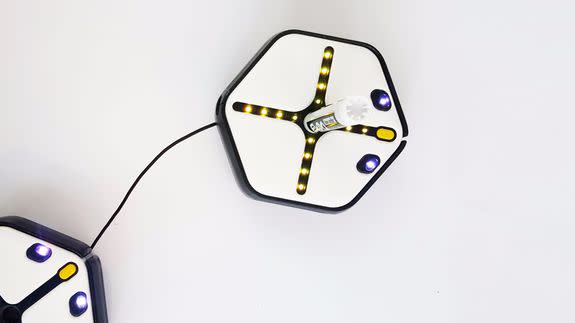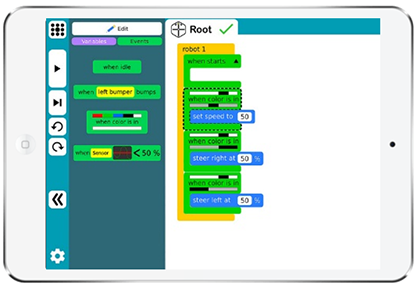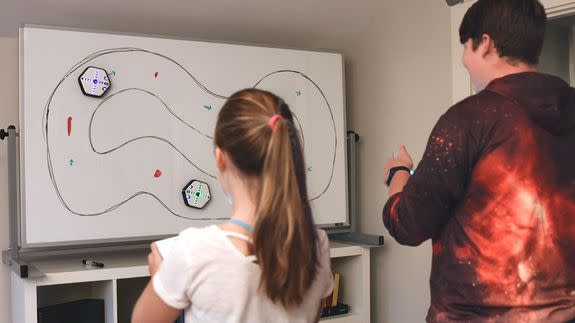This robot teach can teach you how to code by climbing on walls

Some robots make people feel like climbing the wall, and other robots climb the walls themselves.
Root a new code-teaching robot is the latest in a long line of teaching bots designed to inspire students in Science, Technology, Engineering and Math (STEM) studies. However, this bot, still in Kickstarter mode, is different.
First of all, it’s designed to teach coding skills to everyone from kindergarten to adulthood. Second, it's potentially more fun than most because it's programming can be carried out vertically — or at least on any wall with metal behind or on it, which may make it the perfect classroom robot since there's a metal-backed whiteboard at the front of most classrooms.
I'm on the phone with a somewhat anxious Zivthan Dubrovsky, the lead of Harvard’s Bio-Inspired robotics program. Dubrovsky, along with Harvard Computer Science Professor Radhika Nagpal and Raphael Cherney, founded Scansorial (he’s CEO) and helped commercialize a Harvard Laboratory mesh robot concept to turn it into Root.
They also launched the the robot's Kickstarter program, which ends Nov. 29. Dubrovsky tells me he’s worried about people being so consumed with their Thanksgiving plan that they'll overlook Kickstarter campaigns like his. At the time of our conversation, Scansorial’s Root was about $50,000 short of the 250K goal.
Dubrovsky wanted to make it clear that Root is not a toy. "This is not about making a kindergartner happy. We wanted to make a robot that would be acceptable to anybody," he said.

Image: SCANSORIAL
Pretty much every part of the hexagonal robot and iPad-based, code-teaching system is designed to go beyond a simple educational toy and into the realm of tool. Dubrovsky explained that the three-level system will guide students of all ages from the simplistic, building-block style programming interface to old-school, text-based coding.
Early levels give coders gross control of the robot. By Level 3, coders can control everything, including the precise movement of Root's two wheels.
Despite how intense Dubrovsky is or Root may sound, there is a sort of intrinsic entertainment value; the thing can climb walls, after all. Apparently, that was the original, core idea for Root. Dubrovsky's team wondered, "How can we get robots on walls?" They actually started with Harvard Professor Nagpal's swarming robot project, the Kilobot, and then looked at how they could commercialize wall crawlers.
Dubrovsky, who started his career in product design, has been involved with robotics on-and-off for years. He was with iRobot when it was just a few dozen employees and then joined Sonos. Eventually, though, he had to come back to robots, telling me that after you’ve made a bunch of wireless speakers, the challenge kind of wears off.

Image: SCANSORIAL
His work with Harvard's Bio-Inspired robots is all about peeling away the commercial possibilities from projects like Nagpal's.
For Root, the team made Root’s mobility an expression of the programming work done on the companion iPad app. So now all that climbing, or rolling about a table-top or large sheet of paper has a purpose.
Root, which weighs 500 grams and is about 15 centimeters in diameter and 4.5 centimeters tall, is pretty much packed with sensors. It has touch sensors on top, light centers on the front, an accelerometer, gyroscope and an array of 32 color sensors on the bottom. There's also a hole in the center of the robot where you can place a pen, magic marker or dry-erase pen for whiteboards.
Root can even pickup and put down the writing implement to make discrete lines and shapes: it will draw whatever you program in. Dubrovsky used the Level 1 program tools to make Root draw a Cubs logo when the team won the World Series.

Image: SCANSORIAL
The sensors can see line colors, which means that Root can change its behavior depending on the color it encounters on the whiteboard (one that's drawn by itself or another Root robot). It also includes an eraser, which means you can program it to erase certain lines or colors.
Another key difference between Root and other STEM and learn-to-code robots is, according to Dubrovsky, the real-time nature of the platform. "The robot and our app are constantly synchronized," he said. No need to code, compile and test, Root users can see their programming changes live on the Root robot. The iPad and robot stay in constant contact via Bluetooth low energy.
A handful of classrooms are participating in the Root beta program, but, by the time Root ships in December, Dubrovsky envisions three Root robots in a classroom of 25. Each student, though should be programming on their own iPad (the Android app is coming later).

Image: SCANSORIAL
The Root robots do have their limits. There's no on-board camera (though there is an accessory port where you’ll eventually be able to add one) and the robots are completely unaware of each other. No swarming for them.
Dubrovsky shared one other interesting tidbit about his project: the root of the name Root. Root is a coding term, he said, and it also refers to education, as in that’s how you grow, start at the root and grow up.
"It's also Root takes the 'BS' out of 'Robots,'" he added with a laugh.
Very clever.

 Yahoo News
Yahoo News 